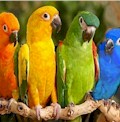For any new pet moving to a new home can be a very traumatic experience and in some cases even more so for a pet bird. Many times if bird was hand fed as a baby it may have stronger attachments then other birds. However if you take the time setting up your birds new environment properly with some extra care, it will a bit easier for your pet bird to make the adjustment to it's new home.
One of the most important things you should first do when you bring your new bird home is to place its cage in an area that does not have an over abundance of activity or confusion. Even though we are trying to make sure our new friend doesn't feel like he is caught up in the middle of all the household action. We also want to make sure that he does not feel all alone by putting him in some unused room by him self. Ideally you want to find a spot in your home where he can still interact with you, but there won't be constant loud noises or lots of sudden movements that can continually startle him.
In situations where you already have another bird in your home, it would be best to segregate your new arrival for about thirty days. The reason you want to do this is to help ensure that if your new bird has an infectious disease, you won't infect your original bird. When creating a quarantine for your bird, it would be best to keep him on floor in a completely different room of the house. Also make sure to keep their food and water dishes apart and do not interchange them even after washing. If your home has a central air conditioning system, you may have difficulty being able to ensure a true quarantine. Since these kinds of air conditioning system employ air duct systems which carry the air from one room to other rooms in the house. Regardless it is still a good idea to quarantine the new bird than immediately putting exposing him to your original pet even if you have air ducts.
You should also make sure that any new bird you bring home is in good health. So be sure to take him to your local avian veterinarian for a general check up. Your veterinarian will be able to check and make sure that your new pet bird is free of any contagious diseases, worms or bacterial infections. This is even more important in cases were you have a hand fed baby bird, the reason being is that if the bird wasn't properly hand fed it is at a higher risk for having a bacterial infection.
When ever you bring a new bird home you should closely monitor their eating habits during their initial adjustment period. If you notice that your bird doesn't seem to be eating at all during the initial twenty four hours, you should try and offer him some spray millet. Spray millet is pretty much a dessert for birds. Another option is to offer him a whole grain cereal which may coax a frightened bird into eating. If you just brought home a newly weaned baby bird and he is not eating and is also making various squalling noises, your new bird may have regressed some and will need to be hand fed slightly longer. In these situations call your breeder for assistance.
If for some reason you cannot get in contact with your breeder, odds are you can buy some hand feeding formula from your local pet shop. To use the formula simply mix up a tiny quantity of the hand feeding formula until it reaches a consistency close to that of pudding. Then offer some of the mixture to your bird by putting some of the formula on a plastic spoon. If all is well he should eat it right off the spoon.
Lastly, you should not be afraid to interact with your new pet bird, just make sure you don't get out of hand and overdo it. At first you should only try to work with him for 10 minutes at a time and no more. If he continually flies away and you notice your self having to chase and catch him, Just put him away back in his cage for a bit until he starts to calm down. Every time you chase and catch your bird it cause him some stress, which is something we are trying to minimize for our new friend.
